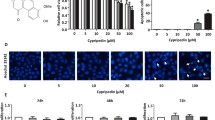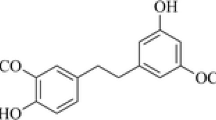Abstract
Metastasis in lung cancer has been recognized as an important cause of high mortality. Resistance to anoikis and the epithelial-to-mesenchymal transition (EMT) are critical factors for the successful spread of cancer cells. Compounds that suppress these features of cancer cells should be potentially active for anti-metastasis approaches. We have demonstrated for the first time that moscatilin, at its non-toxic concentrations to lung cancer cells and human normal keratinocytes, significantly decreases lung cancer cell survival in the detached condition, and suppresses the formation of tumors in an anchorage-independent growth assay. Furthermore, we found that moscatilin significantly decreased the activated level of survival proteins, namely ERK and Akt. In addition, moscatilin down-regulated cavelolin-1 (Cav-1), leading to a reduction in anti-apoptotic Mcl-1 protein. In terms of EMT, treatment of the cells with moscatilin significantly suppressed mesenchymal cell markers, namely vimentin, Slug, and Snail. These results indicate that moscatilin inhibited anoikis resistance in lung cancer cells via survival suppression, Cav-1 down-regulation, and inhibition of EMT. The compound could therefore be beneficial for the treatment and prevention of lung cancer metastasis.






Similar content being viewed by others
References
Zhang Z, Han L, Cao L, Liang X, Liu Y, Liu H, Du J, Qu Z, Zhu C, Liu S, Li H, Sun W (2008) Aggregation formation mediated anoikis resistance of BEL7402 hepatoma cells. Folia Histochem Cytobiol 46:331–336
Yongsanguanchai N, Pongrakhananon V, Mutirangura A, Rojanasakul Y, Chanvorachote P (2015) Nitric oxide induces cancer stem cell-like phenotypes in human lung cancer cells. Am J Physiol Cell Physiol 308:C89–100
Winitthana T, Lawanprasert S, Chanvorachote P (2014) Triclosan potentiates epithelial-to-mesenchymal transition in anoikis-resistant human lung cancer cells. PLoS One 9:e110851
Wheelock MJ, Shintani Y, Maeda M, Fukumoto Y, Johnson KR (2008) Cadherin switching. J Cell Sci 121:727–735
Wang ZL, Fan ZQ, Jiang HD, Qu JM (2013) Selective Cox-2 inhibitor celecoxib induces epithelial-mesenchymal transition in human lung cancer cells via activating MEK-ERK signaling. Carcinogenesis 34:638–646
Voulgari A, Pintzas A (2009) Epithelial–mesenchymal transition in cancer metastasis: mechanisms, markers and strategies to overcome drug resistance in the clinic. Biochim Biophys Acta 1796:75–90
Vega S, Morales AV, Ocana OH, Valdes F, Fabregat I, Nieto MA (2004) Snail blocks the cell cycle and confers resistance to cell death. Genes Dev 18:1131–1143
Valastyan S, Weinberg RA (2011) Tumor metastasis: molecular insights and evolving paradigms. Cell 147:275–292
Tanagornmeatar K, Chaotham C, Sritularak B, Likhitwitayawuid K, Chanvorachote P (2014) Cytotoxic and anti-metastatic activities of phenolic compounds from Dendrobium ellipsophyllum. Anticancer Res 34:6573–6579
Taddei ML, Giannoni E, Fiaschi T, Chiarugi P (2012) Anoikis: an emerging hallmark in health and diseases. J Pathol 226:380–393
Song L, Coppola D, Livingston S, Cress D, Haura EB (2005) Mcl-1 regulates survival and sensitivity to diverse apoptotic stimuli in human non-small cell lung cancer cells. Cancer Biol Ther 4:267–276
Shi Y, Wu H, Zhang M, Ding L, Meng F, Fan X (2013) Expression of the epithelial-mesenchymal transition-related proteins and their clinical significance in lung adenocarcinoma. Diagn Pathol 8:89. doi:10.1186/1746-1596-8-89
Sever R, Brugge JS (2015) Signal transduction in cancer. Cold Spring Harb Perspect Med. doi:10.1101/cshperspect.a006098
Sabbah M, Emami S, Redeuilh G, Julien S, Prévost G, Zimber A, Ouelaa R, Bracke M, De Wever O, Gespach C (2008) Molecular signature and therapeutic perspective of the epithelial-to-mesenchymal transitions in epithelial cancers. Drug Resist Updat 11:123–151
Reddy P, Liu L, Ren C, Lindgren P, Boman K, Shen Y, Lundin E, Ottander U, Rytinki M, Liu K (2005) Formation of E-cadherin-mediated cell-cell adhesion activates AKT and mitogen activated protein kinase via phosphatidylinositol 3 kinase and ligand-independent activation of epidermal growth factor receptor in ovarian cancer cells. Mol Endocrinol 19:2564–2578
Ravid D, Maor S, Werner H, Liscovitch M (2006) Caveolin-1 inhibits anoikis and promotes survival signaling in cancer cells. Adv Enzyme Regul 46:163–175
Powan P, Chanvorachote P (2014) Nitric oxide mediates cell aggregation and mesenchymal to epithelial transition in anoikis-resistant lung cancer cells. Mol Cell Biochem 393:237–245
Peinado H, Olmeda D, Cano A (2007) Snail, Zeb and bHLH factors in tumour progression: an alliance against the epithelial phenotype? Nat Rev Cancer 7:415–428
Paoli P, Giannoni E, Chiarugi P (2013) Anoikis molecular pathways and its role in cancer progression. Biochim Biophys Acta 1833:3481–3498
Pai HC, Chang LH, Peng CY, Chang YL, Chen CC, Shen CC, Teng CM, Pan SL (2013) Moscatilin inhibits migration and metastasis of human breast cancer MDA-MB-231 cells through inhibition of Akt and Twist signaling pathway. J Mol Med (Berl) 91:347–356
Onder TT, Gupta PB, Mani SA, Yang J, Lander ES, Weinberg RA (2008) Loss of E-cadherin promotes metastasis via multiple downstream transcriptional pathways. Cancer Res 68:3645–3654
Nurwidya F, Takahashi F, Murakami A, Takahashi K (2012) Epithelial mesenchymal transition in drug resistance and metastasis of lung cancer. Cancer Res Treat 44:151–156
Meng F, Wu G (2012) The rejuvenated scenario of epithelial-mesenchymal transition (EMT) and cancer metastasis. Cancer Metastasis Rev 31:455–467
Ma XK, Wang L, Li Y, Yang XM, Zhao P, HaoTang ZhuP, Li L, Chen ZN (2010) HAb18G/CD147 cell-cell contacts confer resistance of a HEK293 subpopulation to anoikis in an E-cadherin-dependent manner. BMC Cell Biol 11:27. doi:10.1186/1471-2121-11-27
Luanpitpong S, Talbott SJ, Rojanasakul Y, Nimmannit U, Pongrakhananon V, Wang L, Chanvorachote P (2010) Regulation of lung cancer cell migration and invasion by reactive oxygen species and caveolin-1. J Biol Chem 285:38832–38840
Lloyd PG (2012) Caveolin-1, antiapoptosis signaling, and anchorage-independent cell growth. Focus on “Caveolin-1 regulates Mcl-1 stability and anoikis in lung carcinoma cells”. Am J Physiol Cell Physiol 302:C1282–C1283
Li L, Ren CH, Tahir SA, Ren C, Thompson TC (2003) Caveolin-1 maintains activated Akt in prostate cancer cells through scaffolding domain binding site interactions with and inhibition of serine/threonine protein phosphatases PP1 and PP2A. Mol Cell Biol 23:9389–9404
Larue L, Bellacosa A (2005) Epithelial-mesenchymal transition in development and cancer: role of phosphatidylinositol 3′ kinase/AKT pathways. Oncogene 24:7443–7454
Kowitdamrong A, Chanvorachote P, Sritularak B, Pongrakhananon V (2013) Moscatilin inhibits lung cancer cell motility and invasion via suppression of endogenous reactive oxygen species. Biomed Res Int 2013:765894
Klymkowsky MW, Savagner P (2009) Epithelial-mesenchymal transition: a cancer researcher’s conceptual friend and foe. Am J Pathol 174:1588–1593
Klongkumnuankarn P, Busaranon K, Chanvorachote P, Sritularak B, Jongbunprasert V, Likhitwitayawuid K (2015) Cytotoxic and antimigratory activities of phenolic compounds from Dendrobium brymerianum. Evid Based Complement Alternat Med 2015:350410
Kang HG, Jenabi JM, Zhang J, Keshelava N, Shimada H, May WA, Ng T, Reynolds CP, Triche TJ, Sorensen PH (2007) E-cadherin cell-cell adhesion in ewing tumor cells mediates suppression of anoikis through activation of the ErbB4 tyrosine kinase. Cancer Res 67:3094–3105
Ho CK, Chen CC (2003) Moscatilin from the orchid Dendrobrium loddigesii is a potential anticancer agent. Cancer Invest 21:729–736
Ho CC, Huang PH, Huang HY, Chen YH, Yang PC, Hsu SM (2002) Up-regulated caveolin-1 accentuates the metastasis capability of lung adenocarcinoma by inducing filopodia formation. Am J Pathol 161:1647–1656
Guarino M (2007) Epithelial–mesenchymal transition and tumour invasion. Int J Biochem Cell Biol 39:2153–2160
Guadamillas MC, Cerezo A, Del Pozo MA (2011) Overcoming anoikis–pathways to anchorage-independent growth in cancer. J Cell Sci 124:3189–3197
Geiger TR, Peeper DS (2009) Metastasis mechanisms. Biochim Biophys Acta 1796:293–308
Gavert N, Ben-Ze’ev A (2008) Epithelial–mesenchymal transition and the invasive potential of tumors. Trends Mol Med 14:199–209
Floor SL, Dumont JE, Maenhaut C, Raspe E (2012) Hallmarks of cancer: of all cancer cells, all the time? Trends Mol Med 18:509–515
Fenouille N, Tichet M, Dufies M, Pottier A, Mogha A, Soo JK, Rocchi S, Mallavialle A, Galibert MD, Khammari A, Lacour JP, Ballotti R, Deckert M, Tartare-Deckert S (2012) The epithelial-mesenchymal transition (EMT) regulatory factor SLUG (SNAI2) is a downstream target of SPARC and AKT in promoting melanoma cell invasion. PLoS One 7:e40378
Eccles SA, Welch DR (2007) Metastasis: recent discoveries and novel treatment strategies. Lancet 369:1742–1757
Chunhacha P, Sriuranpong V, Chanvorachote P (2013) Epithelial-mesenchymal transition mediates anoikis resistance and enhances invasion in pleural effusion-derived human lung cancer cells. Oncol Lett 5:1043–1047
Chunhacha P, Pongrakhananon V, Rojanasakul Y, Chanvorachote P (2012) Caveolin-1 regulates Mcl-1 stability and anoikis in lung carcinoma cells. Am J Physiol Cell Physiol 302:C1284–C1292
Chunhacha P, Chanvorachote P (2012) Roles of caveolin-1 on anoikis resistance in non small cell lung cancer. Int J Physiol Pathophysiol Pharmacol 4:149–155
Chiarugi P, Giannoni E (2008) Anoikis: a necessary death program for anchorage-dependent cells. Biochem Pharmacol 76:1352–1364
Chanvorachote P, Kowitdamrong A, Ruanghirun T, Sritularak B, Mungmee C, Likhitwitayawuid K (2013) Anti-metastatic activities of bibenzyls from Dendrobium pulchellum. Nat Prod Commun 8:115–118
Chanvorachote P, Chunhacha P, Pongrakhananon V (2013) Anoikis: a potential target to prevent lung cancer metastasis? Lung Cancer Manage 2:169–171
Chaffer CL, Weinberg RA (2011) A perspective on cancer cell metastasis. Science 331:1559–1564
Baum B, Settleman J, Quinlan MP (2008) Transitions between epithelial and mesenchymal states in development and disease. Semin Cell Dev Biol 19:294–308
Acknowledgments
This research was funded by the Ratchadapiseksompoch Endowment Fund (2014), Chulalongkorn University (CU-57-003-HR).
Author information
Authors and Affiliations
Corresponding author
Ethics declarations
Conflict of interest
All authors declare no conflict of interest.
Rights and permissions
About this article
Cite this article
Busaranon, K., Plaimee, P., Sritularak, B. et al. Moscatilin inhibits epithelial-to-mesenchymal transition and sensitizes anoikis in human lung cancer H460 cells. J Nat Med 70, 18–27 (2016). https://doi.org/10.1007/s11418-015-0931-7
Received:
Accepted:
Published:
Issue Date:
DOI: https://doi.org/10.1007/s11418-015-0931-7




